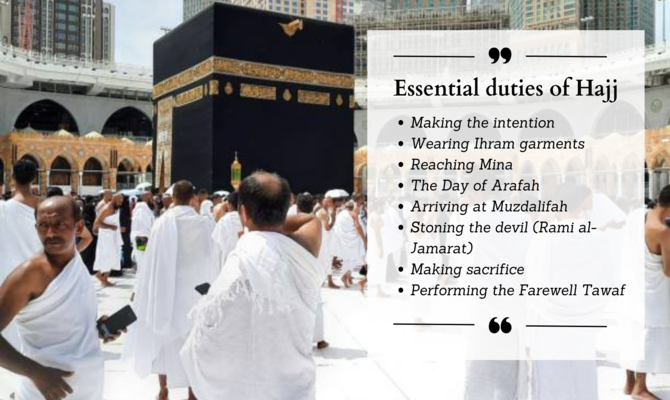As we know, every year, Muslims from every corner of the world travel to Mecca to fulfil a religious obligation. This spiritual journey is typically known as the Hajj. Every Muslim desire to make this religious journey because it is one of the fundamental requirements of Islam. This spiritual trip has a historical background, enormous significance, and numerous remarkable facts. This sacred pilgrimage is a beautiful collection of various ceremonies and duties. For further details, study the complete description in this article: “What are the essential duties of Hajj?”
Muslims travel to Mecca each year to accomplish the Hajj for religious reasons. Every Muslim who is physically capable and has enough recourses must complete this pilgrimage at least once throughout his lifetime. There are numerous duties and rituals associated with Hajj, including making the intention, reaching Mina, and performing the farewell Tawaf.
Note: People must have authentic knowledge about the Hajj and its rules and regulations before booking Hajj Packages.
Hajj – essential duties
The Hajj rituals continue for five or six days. These ceremonies generally begin on the 8th of Dhul Hijjah and end on the 13th of the same month. This holy journey is the largest religious gathering that takes place each year in Islam. A spiritual trip to Mecca contains various basic rituals. These fundamental duties include the following:
- Making the intention
- Wearing Ihram garments
- Reaching Mina
- The Day of Arafah
- Arriving at Muzdalifah
- Stoning the devil (Rami al-Jamarat)
- Making sacrifice
- Performing the Farewell Tawaf
Making the intention:
Making a sincere intention is one of the major rituals of Hajj. The Prophet Muhammad (PBUH) emphasized to Muslims the importance of making intentions before starting any activity because actions are dependent on intentions. In this way, Hajj is an amazing representation of dedication to Allah Almighty. Pilgrims should have an intention when they begin a religious pilgrimage to Mecca.
Wearing Ihram garments:
Pilgrims must wear Ihram garments after making an intention. These garments contain loose-fitting clothing for women and two unstitched white sheets for men. Pilgrims must wear Ihram for the Hajj before crossing the Miqat, the outer premises of Mecca. After attaining the virtuous state of Ihram, they must perform Tawaf al-Qudoom and Sa’i inside the walls of Masjid al-Haram.
Read Also: Most beautiful tourist places in Saudi Arabia
Reaching Mina:
Mecca is 6 kilometres away from the small town of Mina. They must stay and rest there till the next day when pilgrims arrive in this small town. Pilgrims offer all five prayers when they reach Mina, starting with the noon prayer and ending with the Morning Prayer.
The Day of Arafah:
Before noon on the 9th of Dhul Hijjah, pilgrims gather in Arafat, an arid region 22.6 kilometres east of Mecca. They maintain an appropriate vigil and seek forgiveness for their previous wrongdoings from the gracious God. Furthermore, they listen to the sermon delivered by Islamic scholars from close to Mount Arafat. According to Islamic tradition, the last Prophet Muhammad (PBUH) gave his final sermon on this mountain.
Arriving at Muzdalifah:
Muzdalifah, a little village between Mount Arafat and Mina, is the next destination for pilgrims. Pilgrims offer both sunset prayer and night prayer together when they reach this place at sunset. They spend an entire night under the open sky and collect 49 pebbles of similar size for the ceremony of Rami al-Jamarat. They depart from this small town on the morning of the 10th of Dhul Hijjah.
Stoning the devil (Rami al-Jamarat):
Pilgrims engage in the ceremony of Rami al-Jamarat-Aqabah when they reach Mina. They threw seven pebbles at the column structure. This act is done in honour of Abraham when the devil attempted to discourage him from following God’s order. Abraham’s response was to throw some pebbles to scare the devil away.
Making sacrifice:
After completing Rami, pilgrims slaughter animals to remember the tale of the two Prophets Ibrahim (A.S.) and Ismael (A.S.). This sacrificed animal can be a camel or a lamb. Pilgrims should distribute slaughtered animal meat to the poor.
Performing the Farewell Tawaf:
The farewell circumambulation is the last act that a pilgrim must perform after completing the Hajj before leaving Mecca. However, this ceremony is only necessary for the Hajj pilgrims who have travelled from outside the premises of the Miqat. Therefore, people who live within the premises of the Miqat are exempt from having to make this circumambulation.
Conclusion
In conclusion, the Hajj is an annual journey to Mecca for religious reasons. It is the world’s largest religious gathering. This spiritual journey demonstrates the moral values of kindness, brotherhood, and love among Muslims. It also has great significance and various essential duties. These duties include wearing Ihram clothing, stoning the devil, and arriving at Mina. People can perform a holy journey to Mecca after booking Hajj and Umrah Packages from any reliable travel agency.




